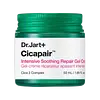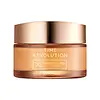What's inside
What's inside
 Key Ingredients
Key Ingredients

 Benefits
Benefits

 Concerns
Concerns

No concerns
 Ingredients Side-by-side
Ingredients Side-by-side

Water
Skin ConditioningDipropylene Glycol
HumectantGlycerin
HumectantButylene Glycol
HumectantCaprylyl Methicone
Skin ConditioningPentylene Glycol
Skin ConditioningNiacinamide
Smoothing1,2-Hexanediol
Skin ConditioningCetearyl Olivate
Theobroma Cacao Extract
Skin ConditioningCentella Asiatica Leaf Extract
Skin ConditioningHydrogenated Polydecene
EmollientGlyceryl Caprylate
EmollientAllantoin
Skin ConditioningAsiaticoside
AntioxidantMadecassic Acid
Skin ConditioningAsiatic Acid
Skin ConditioningAdenosine
Skin ConditioningPolyglyceryl-4 Oleate
EmulsifyingSodium Stearoyl Glutamate
CleansingPalmitoyl Tripeptide-8
Skin ConditioningSorbitan Olivate
EmulsifyingC14-22 Alcohols
Emulsion StabilisingTromethamine
BufferingAmmonium Acryloyldimethyltaurate/Vp Copolymer
Acrylates/C10-30 Alkyl Acrylate Crosspolymer
Emulsion StabilisingCarbomer
Emulsion StabilisingBoron Nitride
AbsorbentPropanediol
SolventIsopentyldiol
HumectantDextrin
AbsorbentC12-20 Alkyl Glucoside
EmulsifyingSodium Surfactin
CleansingDextran
Sodium Phytate
CI 19140
Cosmetic ColorantCI 42090
Cosmetic ColorantWater, Dipropylene Glycol, Glycerin, Butylene Glycol, Caprylyl Methicone, Pentylene Glycol, Niacinamide, 1,2-Hexanediol, Cetearyl Olivate, Theobroma Cacao Extract, Centella Asiatica Leaf Extract, Hydrogenated Polydecene, Glyceryl Caprylate, Allantoin, Asiaticoside, Madecassic Acid, Asiatic Acid, Adenosine, Polyglyceryl-4 Oleate, Sodium Stearoyl Glutamate, Palmitoyl Tripeptide-8, Sorbitan Olivate, C14-22 Alcohols, Tromethamine, Ammonium Acryloyldimethyltaurate/Vp Copolymer, Acrylates/C10-30 Alkyl Acrylate Crosspolymer, Carbomer, Boron Nitride, Propanediol, Isopentyldiol, Dextrin, C12-20 Alkyl Glucoside, Sodium Surfactin, Dextran, Sodium Phytate, CI 19140, CI 42090
Water
Skin ConditioningGlycerin
HumectantTheobroma Grandiflorum Seed Butter
Skin ConditioningSqualane
EmollientDicaprylyl Ether
EmollientCyclohexasiloxane
EmollientDiisostearyl Malate
EmollientCetearyl Alcohol
EmollientPentylene Glycol
Skin ConditioningButyrospermum Parkii Butter
Skin ConditioningDipropylene Glycol
HumectantHydrogenated Castor Oil Isostearate
Skin ConditioningNiacinamide
SmoothingPhenyl Trimethicone
Skin ConditioningPhytosteryl/Isostearyl/Cetyl/Stearyl/Behenyl Dimer Dilinoleate
Skin Conditioning1,2-Hexanediol
Skin ConditioningSynthetic Beeswax
Emulsion StabilisingGlyceryl Stearate Se
EmulsifyingPolymethylsilsesquioxane
C12-16 Alcohols
EmollientHelichrysum Italicum Flower Water
Skin ConditioningPanthenol
Skin ConditioningHydroxyethyl Acrylate/Sodium Acryloyldimethyl Taurate Copolymer
Emulsion StabilisingCetearyl Olivate
Sorbitan Olivate
EmulsifyingPalmitic Acid
EmollientHydrogenated Lecithin
EmulsifyingCetearyl Glucoside
EmulsifyingGlucose
HumectantChlorella Vulgaris Extract
Skin ConditioningParfum
MaskingButylene Glycol
HumectantCarbomer
Emulsion StabilisingCopernicia Cerifera Wax
Tromethamine
BufferingSodium Acrylate/Sodium Acryloyldimethyl Taurate Copolymer
Emulsion StabilisingAngelica Archangelica Callus Extract
Skin ProtectingFructooligosaccharides
HumectantFructose
HumectantXanthan Gum
EmulsifyingPolyisobutene
Ethylhexylglycerin
Skin ConditioningOctanediol
Adenosine
Skin ConditioningSodium Phytate
Melia Azadirachta Flower Extract
Skin ConditioningCaprylic/Capric Triglyceride
MaskingOcimum Sanctum Leaf Extract
Skin ConditioningMelia Azadirachta Leaf Extract
Skin ConditioningCaprylyl/Capryl Glucoside
CleansingSorbitan Oleate
EmulsifyingCurcuma Longa Root Extract
MaskingCorallina Officinalis Extract
Skin ConditioningDextrin
AbsorbentTheobroma Cacao Seed Extract
AntioxidantTocopherol
AntioxidantPolyglyceryl-10 Oleate
Skin ConditioningPolyglyceryl-5 Oleate
EmulsifyingLimnanthes Alba Seed Oil
Skin ConditioningSodium Stearoyl Glutamate
CleansingHydrogenated Vegetable Oil
EmollientHydroxystearic Acid
CleansingMaltodextrin
AbsorbentPolyglyceryl-3 Methylglucose Distearate
EmulsifyingSwertia Chirata Extract
HumectantCholeth-24
EmulsifyingCeramide NP
Skin ConditioningWater, Glycerin, Theobroma Grandiflorum Seed Butter, Squalane, Dicaprylyl Ether, Cyclohexasiloxane, Diisostearyl Malate, Cetearyl Alcohol, Pentylene Glycol, Butyrospermum Parkii Butter, Dipropylene Glycol, Hydrogenated Castor Oil Isostearate, Niacinamide, Phenyl Trimethicone, Phytosteryl/Isostearyl/Cetyl/Stearyl/Behenyl Dimer Dilinoleate, 1,2-Hexanediol, Synthetic Beeswax, Glyceryl Stearate Se, Polymethylsilsesquioxane, C12-16 Alcohols, Helichrysum Italicum Flower Water, Panthenol, Hydroxyethyl Acrylate/Sodium Acryloyldimethyl Taurate Copolymer, Cetearyl Olivate, Sorbitan Olivate, Palmitic Acid, Hydrogenated Lecithin, Cetearyl Glucoside, Glucose, Chlorella Vulgaris Extract, Parfum, Butylene Glycol, Carbomer, Copernicia Cerifera Wax, Tromethamine, Sodium Acrylate/Sodium Acryloyldimethyl Taurate Copolymer, Angelica Archangelica Callus Extract, Fructooligosaccharides, Fructose, Xanthan Gum, Polyisobutene, Ethylhexylglycerin, Octanediol, Adenosine, Sodium Phytate, Melia Azadirachta Flower Extract, Caprylic/Capric Triglyceride, Ocimum Sanctum Leaf Extract, Melia Azadirachta Leaf Extract, Caprylyl/Capryl Glucoside, Sorbitan Oleate, Curcuma Longa Root Extract, Corallina Officinalis Extract, Dextrin, Theobroma Cacao Seed Extract, Tocopherol, Polyglyceryl-10 Oleate, Polyglyceryl-5 Oleate, Limnanthes Alba Seed Oil, Sodium Stearoyl Glutamate, Hydrogenated Vegetable Oil, Hydroxystearic Acid, Maltodextrin, Polyglyceryl-3 Methylglucose Distearate, Swertia Chirata Extract, Choleth-24, Ceramide NP
 Reviews
Reviews

Ingredients Explained
These ingredients are found in both products.
Ingredients higher up in an ingredient list are typically present in a larger amount.
1,2-Hexanediol is a synthetic liquid and another multi-functional powerhouse.
It is a:
- Humectant, drawing moisture into the skin
- Emollient, helping to soften skin
- Solvent, dispersing and stabilizing formulas
- Preservative booster, enhancing the antimicrobial activity of other preservatives
Adenosine is in every living organism. It is one of four components in nucleic acids that helps store our DNA.
Adenosine has many benefits when used. These benefits include hydrating the skin, smoothing skin, and reducing wrinkles. Once applied, adenosine increases collagen production. It also helps with improving firmness and tissue repair.
Studies have found adenosine may also help with wound healing.
In skincare products, Adenosine is usually derived from yeast.
Learn more about AdenosineButylene Glycol (or BG) is used within cosmetic products for a few different reasons:
Overall, Butylene Glycol is a safe and well-rounded ingredient that works well with other ingredients.
Though this ingredient works well with most skin types, some people with sensitive skin may experience a reaction such as allergic rashes, closed comedones, or itchiness.
Learn more about Butylene GlycolCarbomer is a polymer of acrylic acid. Its main role is to create a gel consistency.
A high amount of carbomer can cause pilling or balling up of products. Don't worry, most products contain 1% or less of carbomer.
Cetearyl Olivate is an emulsifier and texture enhancer. It is derived from the fatty acids of olive oil and Cetearyl alcohol, and is biodegradable.
As an emulsifier, it is used to prevent oils and waters from separating. It can also
Manufacturers use the name Olivem 1000. This ingredient has been found to preserve the natural microbiome of skin. Having a healthy microbiome helps keep our skin healthy and protects against harmful bacteria. This ingredient is grouped with Sorbitan Olivate under the name Olivem 1000.
Learn more about Cetearyl OlivateDextrin is used to thicken a product and helps bind ingredients together. It is created from starch and glycogen.
As an emulsifier, dextrin prevents ingredients from separating. This helps elongate a product's shelf life.
Studies show coating UV filters with dextrin prevents these ingredients from being absorbed. This helps UV ingredients last longer on the skin.
Learn more about DextrinDipropylene Glycol is a synthetically created humectant, stabilizer, and solvent.
This ingredient helps:
Dipropylene glycol is technically an alcohol, but it belongs to the glycol family (often considered part of the ‘good’ alcohols). This means it is hydrating and gentle on skin unlike drying solvent alcohols like denatured alcohol.
As a masking agent, Dipropylene Glycol can be used to cover the smell of other ingredients. However, it does not have a scent.
Studies show Dipropylene Glycol is considered safe to use in skincare.
Learn more about Dipropylene GlycolGlycerin is already naturally found in your skin. It helps moisturize and protect your skin.
A study from 2016 found glycerin to be more effective as a humectant than AHAs and hyaluronic acid.
As a humectant, it helps the skin stay hydrated by pulling moisture to your skin. The low molecular weight of glycerin allows it to pull moisture into the deeper layers of your skin.
Hydrated skin improves your skin barrier; Your skin barrier helps protect against irritants and bacteria.
Glycerin has also been found to have antimicrobial and antiviral properties. Due to these properties, glycerin is often used in wound and burn treatments.
In cosmetics, glycerin is usually derived from plants such as soybean or palm. However, it can also be sourced from animals, such as tallow or animal fat.
This ingredient is organic, colorless, odorless, and non-toxic.
Glycerin is the name for this ingredient in American English. British English uses Glycerol/Glycerine.
Learn more about GlycerinNiacinamide is a multitasking form of vitamin B3 that strengthens the skin barrier, reduces pores and dark spots, regulates oil, and improves signs of aging.
And the best part? It's gentle and well-tolerated by most skin types, including sensitive and reactive skin.
You might have heard of "niacin flush", or the reddening of skin that causes itchiness. Niacinamide has not been found to cause this.
In very rare cases, some individuals may not be able to tolerate niacinamide at all or experience an allergic reaction to it.
If you are experiencing flaking, irritation, and dryness with this ingredient, be sure to double check all your products as this ingredient can be found in all categories of skincare.
When incorporating niacinamide into your routine, look out for concentration amounts. Typically, 5% niacinamide provides benefits such as fading dark spots. However, if you have sensitive skin, it is better to begin with a smaller concentration.
When you apply niacinamide to your skin, your body converts it into nicotinamide adenine dinucleotide (NAD). NAD is an essential coenzyme that is already found in your cells as "fuel" and powers countless biological processes.
In your skin, NAD helps repair cell damage, produce new healthy cells, support collagen production, strengthen the skin barrier, and fight environmental stressors (like UV and pollution).
Our natural NAD levels start to decline with age, leading to slower skin repair, visible aging, and a weaker skin barrier. By providing your skin niacinamide, you're recharging your skin's NAD levels. This leads to stronger, healthier, and younger looking skin.
Another name for vitamin B3 is nicotinamide. This vitamin is water-soluble and our bodies don't store it. We obtain Vitamin B3 from either food or skincare. Meat, fish, wheat, yeast, and leafy greens contain vitamin B3.
The type of niacinamide used in skincare is synthetically created.
Learn more about NiacinamidePentylene glycol is typically used within a product to thicken it. It also adds a smooth, soft, and moisturizing feel to the product. It is naturally found in plants such as sugar beets.
The hydrophilic trait of Pentylene Glycol makes it a humectant. As a humectant, Pentylene Glycol helps draw moisture from the air to your skin. This can help keep your skin hydrated.
This property also makes Pentylene Glycol a great texture enhancer. It can also help thicken or stabilize a product.
Pentylene Glycol also acts as a mild preservative and helps to keep a product microbe-free.
Some people may experience mild eye and skin irritation from Pentylene Glycol. We always recommend speaking with a professional about using this ingredient in your routine.
Pentylene Glycol has a low molecular weight and is part of the 1,2-glycol family.
Learn more about Pentylene GlycolSodium Phytate is the synthetic salt form of phytic acid. Phytic acid is an antioxidant and can be found in plant seeds.
Sodium Phytate is a chelating agent. Chelating agents help prevent metals from binding to water. This helps stabilize the ingredients and the product.
Sodium Stearoyl Glutamate is an emulsifier and helps condition the skin. It is amino acid-based.
In higher amounts, it may act as a cleansing agent.
Sorbitan Olivate is created from the fatty acids in olive oil and sorbitol.
This ingredient is an oil in water emulsifier. It helps stabilize a product by preventing oils and waters from separating. Sorbitan Olivate also helps hydrate the skin.
Manufacturers sell sorbitan olivate under the name OliveM 1000. OliveM 1000 a multifunctional ingredient. It is self-emulsifying. According to a manufacturer, OliveM 1000 does not disrupt natural skin biome.
Due to its olive oil base, this ingredient may not be fungal-acne safe.
Learn more about Sorbitan OlivateTromethamine helps balance the pH and improve the texture of a product. It is synthetically created.
As an emulsifier, Tromethamine prevents oil and water ingredients from separating. This helps stabilize the product and elongate a product's shelf life. Tromethamine also makes a product thicker.
Tromethamine helps balance the pH level of a product. Normal pH level of skin is slightly acidic (~4.75-5.5). The acidity of our skin is maintained by our glands and skin biome. Being slightly acidic allows our skin to create an "acid mantle". This acid mantle is a thin barrier that protects our skin from bacteria and contaminants.
Oral Tromethanmine is an anti-inflammatory drug but plays the role of masking, adding fragrance, and/or balancing pH in skincare.
1,3-Propanediol, 2-amino-2-(hydroxymethyl)-
Learn more about TromethamineWater. It's the most common cosmetic ingredient of all. You'll usually see it at the top of ingredient lists, meaning that it makes up the largest part of the product.
So why is it so popular? Water most often acts as a solvent - this means that it helps dissolve other ingredients into the formulation.
You'll also recognize water as that liquid we all need to stay alive. If you see this, drink a glass of water. Stay hydrated!
Learn more about Water